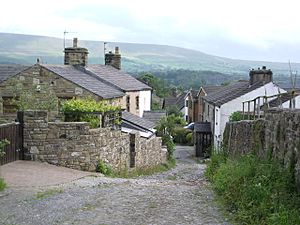Grindletonians facts for kids
| Founder | |
|---|---|
| John Wilson, Roger Brearley | |
| Regions with significant populations | |
| Yorkshire and Lancashire, England | |
| Religions | |
| Christianity | |
| Scriptures | |
| Christian Bible | |
| Languages | |
| English |
The Grindletonians were a special group of Puritan Christians. They started in a town called Grindleton in England around 1610. This group was active in northern England until the 1660s. Their most important leader was Roger Brearley. The Grindletonians had beliefs that were called Antinomian. This meant they thought that if you truly had God's Spirit, you didn't need to follow all the strict rules of the church.
History of the Grindletonians
Before the Grindletonians officially appeared, a man named John Wilson led a church group in Kildwick. He was known for having some new religious ideas. It's possible that some of the Grindletonian beliefs were already present in the community before Roger Brearley arrived.
Roger Brearley was the main leader of the Grindletonians. He worked as a minister in Grindleton from 1615 to 1622. John Everard, another preacher, was Brearley's friend and might have influenced his ideas.
Brearley became well-known because of his teachings. People from nearby areas, like Giggleswick, came to hear him. However, his ideas were seen as different from the main church. In October 1616, he was called before a special church court called the High Commission of the Archdiocese of York.
He faced charges for being a "radical nonconformist." This meant he didn't follow the usual church rules. People said he relied too much on his own "spirit" and believed that true Christians could be sure of their salvation. He was also asked to reject fifty ideas that the church thought were wrong. To avoid punishment, Brearley seemed to agree to change his views and follow the rules.
Brearley left Grindleton in 1634 and moved to Kildwick. His replacement in Grindleton was John Webster. Webster taught ideas similar to Brearley's. Because of this, the Grindletonian movement continued to grow between 1615 and 1640. It gained many followers in Lancashire and Yorkshire. Other groups with similar "Antinomian" beliefs also started. In 1635, John Webster was also brought before a church court for being a Grindletonian.
Later, in the 1640s, a preacher named Robert Towne helped spread the Grindletonian message. He traveled through western Yorkshire and eastern Lancashire. Even though he spread their ideas, he didn't like being called a Grindletonian himself. The last known Grindletonian person died in the 1680s.
What Grindletonians Believed
The Grindletonians had some unique beliefs. Their main idea was called antinomianism. This meant they believed that God's Spirit alone was enough to help a person become saved. They thought that if a true Christian had God's Spirit inside them, that person would not sin.
They were similar to another group called the Familists. Grindletonians believed that the "Spirit" (meaning inner spiritual guidance) was more important than the "Letter" (meaning the strict rules written in the Bible). They also thought that anyone who had this "inner light" or spiritual understanding could preach, even if they weren't officially ordained ministers. They even believed that a person could live without sin and experience a kind of "Heaven on Earth."
Who They Influenced
Grindleton is located near Pendle Hill. This is the place where George Fox, who started the Quaker religion, had important spiritual experiences. Many other new religious groups also started in this area around the same time. It's possible that George Fox and the Quakers were influenced by Grindletonian ideas.
Some people who were Grindletonians later became Quakers. For example, Francis Howgill and John Camm were first Grindletonians, then joined a group called the Seekers, and finally became Quakers.
Grindletonian ideas might have also influenced Anne Hutchinson. She was an important religious figure in early American history.


